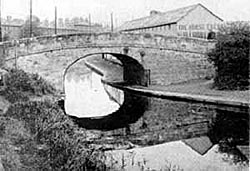< Previous | Contents | Next >
London Road and an old canal bridge
 |
LONDON ROAD is the ancient way into Nottingham from the south, and in olden days was carried in places upon arches so as to escape floods, and to cross over the Tinker’s Leen.
The upkeep of this road and these arches is a complicated story. Suffice it to say that when the ground on the western side of the road was open, common land, and the East Croft was a pleasant meadow, the drive from Trent Bridge to Nottingham was said by coach travellers to be the pleasantest and most picturesque mile anywhere in the neighbourhood.
The roadway itself got into a deplorable state, and was turnpiked and put into reasonable order in 1796.
As Carrington Street was not formed until about 1829, and Arkwright Street does not appear until many years after that date, it follows that all south-going traffic had to pass along London Road, and the turnpike-gate that stood across the road just about level with its junction with Meadow Lane must have been an exceedingly busy and profitable point.
This gate swung on its hinges to allow the passage of many wayfarers, including that of the coach bearing the tidings of Wellington’s victory at Waterloo, and that of the ill-omened vehicle that carried the news of the rejection of the Reform Bill in 1831, news that was the overture to the sack of Coiwick Hall and the burning of Nottingham Castle.
But although the roadways of Britain had been much improved during the 18th Century, traffic was difficult. Macadam had not yet come into the world to teach people how to make roads of broken stone, and so wherever possible water was used for transport. Gradually a system of canals grew up throughout the length and breadth of the country.
In 1793, Nottingham was joined to the Trent by the canal that is familiar to all of us, and a great boon it proved, for it enabled waterborne traffic to come to the very doors of Nottingham tradesfolk.
The canal was crossed by bridges bearing ancient footways, and the bridge shown in this picture was one of these, and dates from about the time of Lord Howe’s naval victory on 1 June, 1794, or about the time of John Wesley’s death.
